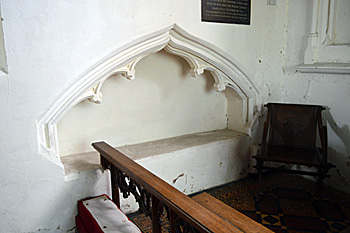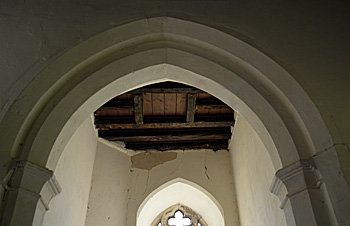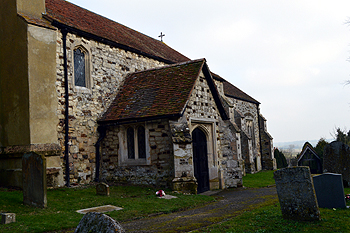Hockliffe Church Architecture
![Hocklife Church about 1920 [Z1130-60-1]](/CommunityHistories/Hockliffe/HockliffeImages/Hocklife Church about 1920 [Z1130-60-1]_350x219.jpg)
Hocklife Church about 1920 [Z1130/60/1]
The earliest dateable parts of the Church of Saint Nicholas at Hockliffe are from the 14th century, but the first known reference to the rector dates from 1218 so it is clear that a church was in existence well before this date. It is possible that the nave incorporates masonry from the original church.

Piscina July 2015
Hockliffe Church is built from Totternhoe stone and ironstone, largely in the perpendicular style. The 14th century chancel includes a large trefoil-headed piscina under a gabled head; to the west of the piscina are two plain sedilia with a three-light window above.

Easter sepulchre July 2015
Other original 14th century features are the half-octagonal jambs and moulded capitals of the chancel arch and an Easter sepulchre. The east window dates from the 15th century.

West tower arch July 2015
The tower with its battlemented parapet was also added in the 15th century. The tower arch is in two pointed chamfered orders, with moulded capitals to the inner arch.

The west tower door July 2015
The west window and the belfry windows have two cinquefoiled lights. In the south-west corner of the tower there is a stair turret.

The south porch February 2013
The aisleless nave was given square headed windows in the late 15th century. The oldest dateable feature in the nave is the 14th century south doorway, to which a south porch with a four-centred doorway with decorated spandrels was added towards the end of the 15th century.

One of the bells July 2015
The belfry holds four bells, three of these are pre-Reformation dating from c.1450 with the fourth being a late 19th century addition. The three medieval bells were probably cast by John Daniel of London. Each bell carries its own individual Latin inscription:
1) Vox Augustini sonet in aure dei - "May the voice of Augustine sound in the ear of God";
2) Sancte Thoma ora pro nobis - "St Thomas pray for us"
3) Sancta Margareta ora pro nobis - "St Margaret pray for us"

The bell frame July 2015